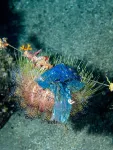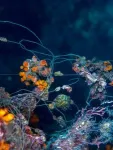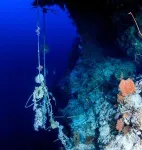(Press-News.org) SAN FRANCISCO, CA (July 12, 2023) — In a paper published today in Nature, researchers from the California Academy of Sciences, University of São Paulo, University of Oxford, University of Exeter, and other collaborators reveal the extent of plastic pollution on coral reefs, finding that debris increases with depth, largely stems from fishing activities, and is correlated with proximity to marine protected areas.
Through underwater visual surveys spanning more than two dozen locations across the Indian, Pacific, and Atlantic oceans, the researchers expose the abundance, distribution, and drivers of plastic pollution at various depths, which in turn enables them to identify what conservation efforts could be prioritized—and where—to protect our planet’s vulnerable coral reefs.
“Plastic pollution is one of the most pressing problems plaguing ocean ecosystems, and coral reefs are no exception,” says Hudson Pinheiro, PhD, the study’s lead author, a biologist at the Center for Marine Biology of the University of São Paulo, and an Academy research fellow. “From macroplastics that spread coral diseases to fishing lines that entangle and damage the structural complexity of the reef, decreasing both fish abundance and diversity, pollution negatively impacts the entire coral reef ecosystem.”
Surveying reefs from shallow to never-before-seen
For the study, the researchers conducted more than 1,200 visual surveys across 84 shallow and mesophotic reef ecosystems located in 14 countries. To survey hard-to-reach mesophotic—or ‘twilight zone’—coral reefs that exist between 100 and 500 feet (30 and 150 meters) deep, researchers relied on specialized diving gear that few other scientific dive teams are trained to safely use.
According to the study, coral reefs appear to be more contaminated by plastics and other human-derived debris than other marine ecosystems that have been evaluated, but are much less polluted than shoreline ecosystems like beaches and wetlands.
However, contrary to studies of near-shore environments, the researchers found that the amount of plastic increased with depth—peaking in the mesophotic zone—and was mostly derived from fishing activities.
“It was surprising to find that debris increased with depth since deeper reefs in general are farther from sources of plastic pollution,” says Luiz Rocha, PhD, Academy curator of ichthyology and co-director of the Academy’s Hope for Reefs initiative, who was the senior author on the study. “We are almost always the first humans to set eyes on these deeper reefs, and yet we see human-produced trash on every dive. It really puts the effect we have had on the planet into perspective.”
Of the total debris, 88% was macroplastics larger than about two inches (five centimeters). The researchers posit that the potential causes of pollution reaching such depths include increased wave action and turbulence near the surface dislodging trash and carrying it away, recreational divers removing debris from more accessible shallow reefs, and shallow corals with higher growth rates overgrowing the trash hiding it from their surveys.
The lowest and highest densities of pollution
Over the course of the study, the researchers found human-derived debris in nearly all locations, including some of the planet’s most remote and pristine coral reefs, such as those adjacent to uninhabited islands in the central Pacific. The lowest densities of pollution—around 580 items per square kilometer—were observed in locations such as the Marshall Islands. Comoros, an island chain off the southeast coast of Africa, had the highest density of pollution with nearly 84,500 items per square kilometer—the equivalent of around 520 pieces of debris on one football field.
Troublingly, the researchers say that because these plastic-laden deeper reefs are more difficult to study, they are rarely included in conservation efforts, management targets, and discussions despite harboring unique biodiversity that’s often not found on shallow reefs.
“Our findings provide more evidence that the mesophotic is not a refuge for shallow reef species in a changing climate as we once thought,” says co-author Bart Shepherd, director of the Academy’s Steinhart Aquarium and co-director of Hope for Reefs. “These reefs face many of the same pressures from human society as shallow reefs, and have a unique and poorly-studied fauna. We need to protect deeper reefs and make sure that they are included in the conservation conversation.”
Fishing gear foremost source of pollution
Although the researchers found much consumer debris, such as water bottles and food wrappers, which are often the main source of plastic pollution in other ecosystems, nearly three-quarters of all plastic items documented on the surveyed reefs were related to fishing like ropes, nets, and fishing lines.
“Fishing gear, which even as debris continues to catch marine life through what we call ghost fishing, appears to contribute a large proportion of the plastic seen on mesophotic reefs,” says co-author Lucy Woodall, PhD, principal scientist of Nekton and associate professor in marine conservation biology and policy at University of Exeter. “Unfortunately, fishing gear debris is often not reduced by general waste management interventions; therefore specific solutions related to the needs of fishers should be considered, such as no-charge disposing of damaged gear in ports or individually labelling gear to ensure fishers take responsibility for misplaced equipment.”
To uncover the drivers of coral reef pollution, the researchers analyzed how the abundance of human-derived debris correlated with a number of geographic and socioeconomic factors. In general, they found pollution on reefs increases with depth and proximity to densely populated cities, local markets, and, counterintuitively, marine protected areas. Since most marine protected areas allow some fishing within or near their borders and are typically more productive than other locations due to their protected status, they are often heavily frequented by fishers, according to the researchers.
“Our findings reveal some of the complex collective challenges we face when dealing with plastic pollution,” Pinheiro says. “As marine resources around the world dwindle, humans that rely on those resources are turning to deeper habitats and those closer to marine protected areas where fish remain abundant.”
Science-based solutions to fight reef pollution
Ultimately, the researchers hope that by teasing out the major drivers of pollution, as well as demonstrating that plastic pollution increases with depth, conservation efforts can be redirected to better protect and ensure a thriving future for Earth’s coral reefs.
“The results of our global study shine a light on one of the many threats that deep reefs face today,” says study author and University of Oxford marine biologist Paris Stefanoudis. “Because these ecosystems are ecologically and biologically unique, much like their shallow-water cousins, they need to be conserved and explicitly considered in management plans.”
In particular, they stress the need to expand the depth of marine protected areas to include mesophotic reefs, update international agreements on combating plastic pollution at their source—such as those discussed at the recent Intergovernmental Negotiating Committee on Plastic Pollution—to include fishing gear, and develop low-cost biodegradable alternatives to fishing gear that will not adversely impact the well-being of coastal communities that rely on sustainable fishing for their livelihoods.
“Despite the disturbing overall trend, there were some places where we found relatively little debris, which shows us that there are effective strategies for preventing plastic pollution,” Shepherd says. “If we act fast and employ science-based solutions, there absolutely is hope for coral reefs.”
END
Plastic pollution on coral reefs increases with depth and mostly comes from fishing activities, Nature study finds
In the most comprehensive survey of plastic pollution on coral reefs to date, researchers find troubling signs of human impact and promising strategies to ramp up protections
2023-07-12
ELSE PRESS RELEASES FROM THIS DATE:
Mast cells as a sensor: Enigmatic immune cells help to avoid harmful allergens
2023-07-12
The function of mast cells, which are part of the immune system, is still a mystery. Scientists at the German Cancer Research Center (DKFZ) have now shown in mice: mast cells function as a sensor that signals the animals to avoid antigens, including harmful allergens, and thereby protect themselves from health-threatening inflammatory reactions. The findings were published in the journal Nature.
Mast cells are found primarily in tissues that separate the outside and inside worlds of the body, such ...
Detailed map of the heart provides new insights into cardiac health and disease
2023-07-12
In a new study, published today (12 July) in Nature, researchers have produced the most detailed and comprehensive human Heart Cell Atlas to date, including the specialised tissue of the cardiac conduction system - where the heartbeat originates.
The multi-centre team is led by the Wellcome Sanger Institute and the National Heart and Lung Institute at Imperial College London, and has also presented a new drug-repurposing computational tool called Drug2cell, which can provide insights into the effects of drugs on heart rate.
This study is part of the international Human Cell Atlas* ...
Second year of COVID pandemic brought spike in child mental health visits to ED
2023-07-12
The number of young people in the United States visiting hospital emergency departments for mental health crises increased sharply during the second year of the COVID-19 pandemic, according to a study led by researchers from the Department of Health Care Policy in the Blavatnik Institute at Harvard Medical School. The findings are published Jul 12 in JAMA Psychiatry.
These results come amidst growing national concern about a crisis in youth mental health and provide important new details about how young people with mental health problems such as self-harm ...
Global study details microplastics contamination in lakes and reservoirs
2023-07-12
LAWRENCE, Kan. — Around 14 million tons of plastic end up in the ocean every year. But that is not the only water source where plastic represents a significant intrusion.
“We found microplastics in every lake we sampled,” said Ted Harris, associate research professor for the Kansas Biological Survey & Center for Ecological Research at the University of Kansas.
“Some of these lakes you think of as clear, beautiful vacation spots. But we discovered such places to be perfect examples of the link between plastics and humans.”
Harris ...
A foundation that fits just right gives superconducting nickelates a boost
2023-07-12
Researchers at the Department of Energy’s SLAC National Accelerator Laboratory and Stanford University say they’ve found a way to make thin films of an exciting new nickel oxide superconductor that are free of extended defects.
Not only does this improve the material’s ability to conduct electricity with no loss, they said, but it also allows them to discover its true nature and properties, both in and out of the superconducting state, for the first time.
Their first look at a superconducting nickel oxide, or nickelate, that does ...
New study using human fibroid cells supports use of green tea compound as treatment for uterine fibroids
2023-07-12
In a pre-clinical, proof-of-concept study from Johns Hopkins Medicine, researchers found that epigallocatechin gallate (EGCG), a green tea compound with powerful antioxidant properties, could be promising for both treating and preventing uterine fibroids. Results of the study, first posted online May 25 in Scientific Reports, add to growing evidence that EGCG may reduce fibroid cell growth. The study was specifically designed to identify the biochemical mechanisms responsible for EGCG action in fibroid cells.
The investigators emphasize that their study involves human fibroid cells grown in the laboratory and treated with EGCG extract to explore the possibility of oral EGCG supplementation ...
The good advice that could lift people out of poverty
2023-07-12
Providing access to housing, debt, and benefit advice within food banks could help lift people out of poverty - according to a University of East Anglia study.
Researchers worked with Norwich Foodbank centres, part of the Trussell Trust, on a pilot project that saw representatives from Citizens Advice and Shelter posted within the service.
The ‘Making a Difference’ initiative meant that people forced to use a food bank were also able to access advice on a range of issues - from housing and debt to benefits.
It is now hoped that this scheme will be rolled out to foodbanks nationally.
Lead researcher Dr Sarah Hanson, from UEA’s School of ...
Amplified Sciences receives $400,000 NCI grant to improve early detection of pancreatic cancer
2023-07-12
WEST LAFAYETTE, Ind. – Health care providers and their patients could know with greater confidence whether pancreatic cysts are benign or potentially malignant, and if surgery is required to remove them, by using a new diagnostic test currently in development.
Amplified Sciences, a clinical-stage life sciences diagnostic company that licenses Purdue University innovations, has received a Phase I Small Business Innovation Research, or SBIR, grant of approximately $400,000 from the National Cancer Institute (NCI) to develop the test. The company focuses on accurately detecting and categorically assessing the risks of debilitating ...
Birmingham start-up awarded funding for technology that generates water out of air
2023-07-12
NovNat Tech Ltd, a visionary new company based in the Unit 9 incubator at the Birmingham Research Park, has secured funding from Innovate UK to develop a novel technology that can generate water out of air.
NovNat Tech is offering solutions to one of the most critical problems of today and the future, the global water scarcity crisis, and is developing a first of its kind ‘atmospheric water harvester’ to help address the global water shortage.
The harvest uses a proprietary material that has already been ...
Webb celebrates first year of science with close-up on birth of sun-like stars
2023-07-12
From our cosmic backyard in the solar system to distant galaxies near the dawn of time, NASA’s James Webb Space Telescope has delivered on its promise of revealing the universe like never before in its first year of science operations. To celebrate the completion of a successful first year, NASA has released Webb’s image of a small star-forming region in the Rho Ophiuchi cloud complex.
“In just one year, the James Webb Space Telescope has transformed humanity’s view of the cosmos, peering ...
LAST 30 PRESS RELEASES:
Manganese gets its moment as a potential fuel cell catalyst
“Gifted word learner” dogs can pick up new words by overhearing their owners’ talk
More data, more sharing can help avoid misinterpreting “smoking gun” signals in topological physics
An illegal fentanyl supply shock may have contributed to a dramatic decline in deaths
Some dogs can learn new words by eavesdropping on their owners
Scientists trace facial gestures back to their source. before a smile appears, the brain has already decided
Is “Smoking Gun” evidence enough to prove scientific discovery?
Scientists find microbes enhance the benefits of trees by removing greenhouse gases
KAIST-Yonsei team identifies origin cells for malignant brain tumor common in young adults
Team discovers unexpected oscillation states in magnetic vortices
How the brain creates facial expressions
Researchers observe gas outflow driven by a jet from an active galactic nucleus
Pitt student finds familiar structure just 2 billion years after the Big Bang
Evidence of cross-regional marine plastic pollution in green sea turtles
Patients with clonal hematopoiesis have increased heart disease risk following cancer treatment
Stem cell therapy for stroke shows how cells find their way in the brain
Environment: Up to 4,700 tonnes of litter flows down the Rhine each year
Maternal vaccine receipt and infant hospital and emergency visits for influenza and pertussis
Interim safety of RSVpreF vaccination during pregnancy
Stem cell engineering breakthrough paves way for next-generation living drugs
California grants $7.4 million to advance gene-edited stem cell therapy for Friedreich’s ataxia
Victoria’s Secret grant backs cutting-edge ovarian cancer research
Research paves the way for safer colonoscopy bowel prep for people with compromised gut health
JMIR Publications and Sweden's National Library announce renewal and expansion of flat-fee unlimited open access partnership for 2026
A new 3D-printed solar cell that’s transparent and color-tunable
IV iron is the cost-effective treatment for women with iron deficiency anemia and heavy menstrual bleeding
Doing good pays off: Environmentally and socially responsible companies drive value and market efficiency
City of Hope and Cellares to automate manufacturing of solid tumor CAR T cell therapy
Short-circuiting pancreatic cancer
Groundbreaking mapping: how many ghost particles all the Milky Way’s stars send towards Earth
[Press-News.org] Plastic pollution on coral reefs increases with depth and mostly comes from fishing activities, Nature study findsIn the most comprehensive survey of plastic pollution on coral reefs to date, researchers find troubling signs of human impact and promising strategies to ramp up protections






